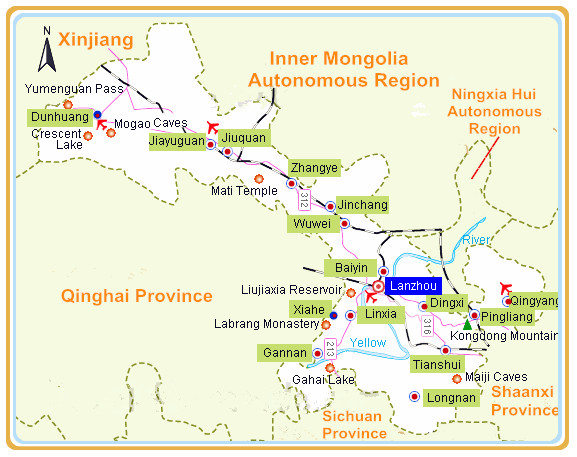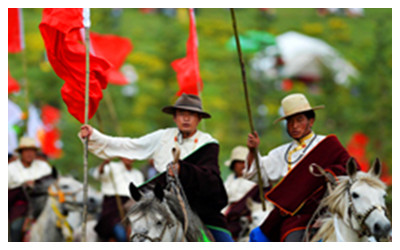
Gannan Tibetan Autonomous Prefecture
 Gannan Tibetan Autonomous Prefecture is one of the 10 Tibetan autonomous prefectures in China. It's located on the northeast edge of the Qing-Tibetan Plateau, 1,100 to 4,900 meters above sea level. Its average altitude is over 3,000 meters. The Gannan Tibetan autonomous prefecture was founded in 1953 with seven counties and one city. In 2011, the Gannan Tibetan autonomous prefecture had a total population of 730,700 and 24 ethnic groups. The ethnic Tibetan population of 395,900 account for 54.2 percent of the total. The city of Hezuo, capital of the Gannan Tibetan autonomous prefecture, sits 2,960 meters above sea level. Its annual average temperature is 3.1 C and annual precipitation is 582.7 millimeters, with no frost-free periods.
Gannan Tibetan Autonomous Prefecture is one of the 10 Tibetan autonomous prefectures in China. It's located on the northeast edge of the Qing-Tibetan Plateau, 1,100 to 4,900 meters above sea level. Its average altitude is over 3,000 meters. The Gannan Tibetan autonomous prefecture was founded in 1953 with seven counties and one city. In 2011, the Gannan Tibetan autonomous prefecture had a total population of 730,700 and 24 ethnic groups. The ethnic Tibetan population of 395,900 account for 54.2 percent of the total. The city of Hezuo, capital of the Gannan Tibetan autonomous prefecture, sits 2,960 meters above sea level. Its annual average temperature is 3.1 C and annual precipitation is 582.7 millimeters, with no frost-free periods.Facts of Gannan
Full Name: Gannan Tibetan Autonomous Prefecture
Chinese Name: 甘南藏族自治州 (gān nán zàng zú zì zhì zhōu)
Population: 682,900
Area: 45,000 square kilometers (17,375 square miles)
Nationalities: Tibetan, Han
Administrative Division: 7 counties: Lintan, Zhuoni (Jone), Luqu, Maqu, Diebu (Tewo), Zhouqu, Xiahe; 1 county-level city (Hezuo)
Seat of the Prefectural Government: Renmin Jie, Hezuo City
 History of Gannan
History of GannanBefore the Qin State in the Spring and Autumn Period (770BC-476BC) partly governed this area, Gannan was the domain of the ancient Qiang (later Tibetan) people, being one of the main birthplaces and residential areas of the Qiangs. It was in the year of 111AD that the Han Dynasty (206BC-220AD) brought Gannan into the feudal regime of Central China. Gannan has played an important role in proving the relationship between the Han and the Tibetan. The south of the Silk Road and the Tang-Tibet Ancient Road all passed through the Gannan region. In 1954, the Gannan Tibetan autonomous prefecture was established with Hezuo city as its capital.
Gannan Physical Features
The prefecture lies in the northeast fringe of the Qinghai-Tibet Plateau at the transition area to the Loess Plateau. The terrain slopes from the northwest to the southeast. It can be divided into three parts: the southern mountainous region with moderate climate, being an important forest zone in Gansu; the eastern hilly area and the eastern meadows and grassland, being the main pasturing area of the province.
Economy of Gannan
In 2011, the city's GDP reached 8.13 billion yuan ($1.33 billion), a year-on-year increase of 10.9 percent. The added value of the primary industry was 1.9 billion yuan, an increase of 6.7 percent year-on-year. The added value of the secondary industry was 2.05 billion yuan, an increase of 14.7 percent year-on-year. The tertiary industry was 4.19 billion yuan, an 11 percent increase. The contribution ratio of the primary industry to GDP was 14.5 percent in 2011. The contributions of the secondary and tertiary industries were 32 percent and 53.5 percent, respectively.
Gannan Competitive Industries
The good ecological environment of the Gannan Tibetan autonomous prefecture provides the region with beautiful natural landscapes, rich nationality characteristics and special folk customs. This region is also an important part of the ancient Silk Road known as Tangfan Ancient Road. There are 14 national-level scenic spots in the autonomous prefecture, which receive 2.44 million domestic and international tourists each year. Livelihood In 2011, per capital disposable income of urban residents was 12,063 yuan, an increase of 16.6 percent compared to 2010.
Gannan Social Undertakings
There are 588 schools in the autonomous prefecture, including 154 primary schools and middle schools providing education in both Tibetan and Chinese Mandarin. The enrollment rate for Tibetan children reached 99.01 percent, and the college acceptance rate for students in the autonomous prefecture hit 85.72 percent in 2011.
In 2011, the Gannan Tibetan autonomous prefecture organized an application for nine scientific and technological programs in total, with four under implementation, with total financing of 34.3 million yuan. Its 49 patent applications have been accepted by the National Intellectual Property Office. By the end of 2011, there were eight artistic groups in the autonomous prefecture, presenting 1,309 performances in total. There were also nine art and cultural centers, three museums and memorial halls , one theater, nine comprehensive archives and nine public libraries in the autonomous prefecture. The 2,164 beds in hospitals and medical organizations and 3,515 medical personnel provide professional medical and health services for people in the autonomous prefecture.



 Ask Questions ?
Ask Questions ?